
Texas is a rural town and locality in the Goondiwindi Region, Queensland, Australia. It is on the border of Queensland and New South Wales. In the 2016 census, Texas had a population of 843 people.

A branch line is a secondary railway line which branches off a more important through route, usually a main line. A very short branch line may be called a spur line.

Inglewood is a rural town and locality in the Goondiwindi Region, Queensland, Australia. In the 2016 census, Inglewood had a population of 954 people. Inglewood is the second largest town in the Goondiwindi Region.
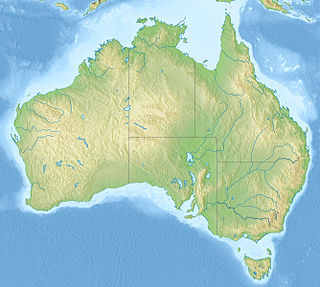
The Brisbane Valley railway line was a railway connection in Queensland, Australia connecting Ipswich, west of Brisbane, to the upper Brisbane River valley. Progressively opened between 1884 and 1913 the railway provided a vital transport link between Ipswich and Yarraman and forged development and prosperity along its path. The line acquired its serpentine reputation because it did not take a straight course when faced with a hill or gully.
The Cooyar railway line was a branch line in the Darling Downs region of Queensland, Australia. The small town of Cooyar is about halfway to Kingaroy in the South Burnett Region. A plan to connect Kingaroy to the south via Cooyar did not eventuate and left Cooyar at the terminus of a branch line running from Oakey west of Toowoomba. It was opened on 28 April 1913 after previous stages to Kulpi and Peranga opened on 29 April 1912 and 4 November 1912 respectively. The line was partially closed beyond Acland on 1 May 1964, with the last segment closed on 8 December 1969.
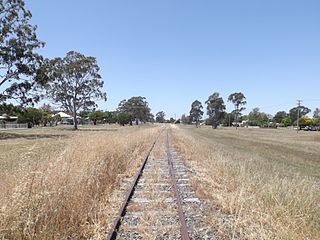
The Millmerran railway line is a 71 kilometre long branch railway in the Darling Downs region of Queensland, Australia.
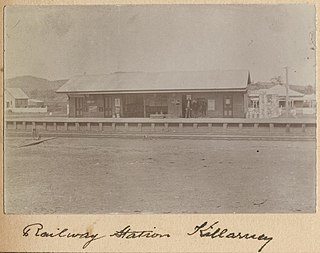
The Killarney railway line was a branch railway in the Darling Downs region of Queensland, Australia. It travelled from Warwick to Killarney and operated from 1884 to 1964.

The Amiens railway line was a branch railway in the Granite Belt region of Queensland, Australia, branching from the Southern Line at Cottonvale between Warwick and Stanthorpe. The Amiens line was the highest in southern Queensland, with the railway reaching an elevation of 946 metres above sea level at Pozieres.
The Maryvale railway line was a branch railway in the Southern Downs region of Queensland, Australia.

The Goomburra railway line was a branch railway in the Southern Downs region of Queensland, Australia.

The Southern railway line serves the Darling Downs region of Queensland, Australia. The 197-kilometre (122 mi) long line branches from the Western line at Toowoomba, 161 kilometres (100 mi) west of Brisbane, and proceeds south through Warwick and Stanthorpe to the New South Wales/Queensland state border at Wallangarra.

Queensland's railway construction commenced in 1864, with the turning of the first sod of the Main Line by Lady Diamantina Bowen, the wife of Queensland's first governor Sir George Bowen at Ipswich, Queensland, Australia. A narrow gauge of 3 ft 6 in was selected due to cost savings in providing a rail link to Toowoomba. Despite being built with bridges wide enough for standard gauge, and the fact that most other lines did not require heavy earthworks, the gauge remained the Queensland system norm.
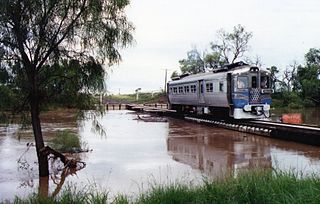
The Glenmorgan Branch is a railway line in south west Queensland, Australia. It opened in a series of sections between 1908 and 1931. It was intended to reach Surat but construction ceased during the 1930s depression and never recommenced.

The Wandoan Branch is a 70 km railway line in the Darling Downs region Queensland, Australia. It links the towns of Miles and Wandoan. It was approved to extend to Taroom, but construction halted during World War I and never recommenced.

The Injune Branch Railway was a railway in Queensland, Australia. After the Western Line reached Roma in south-western Queensland in September 1880, there was a plan to foster land settlement as far as Mount Hutton about 90 kilometres (56 mi) to the north. A branch line from Roma about 40 kilometres (25 mi) to Orallo was approved in 1911 and construction began in 1914. Roma Town Council met one third of the construction cost and it opened on 19 September 1916. Sidings were established en route at Ona Ona, Tineen, Minka, Euthulla, Nullawurt, Yingerbay, Kingull, Nareeten, Oogara, Eumina and Moorta. Three trains a week serviced the line, which followed a path to the west of the present day Carnarvon Highway.
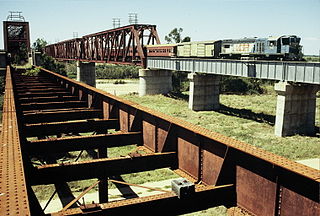
The Great Northern Railway is a 1,067 mm railway line in Queensland, Australia. The line stretches nearly 1,000 kilometres linking the port city of Townsville, Australia to the mining town of Mount Isa in north-west Queensland. Along with a passenger service called the Inlander, it is a major freight route connecting the Mount Isa Mines to the Port of Townsville. In 2010 the line moved 5.8 million tonnes of cargo, and this is expected to increase significantly in coming years.
The Southwestern Railroad is a Class III railroad operating since 1990, and until 2017 consisted of two unconnected railroad sections in New Mexico, with no shared functions. These and a third section in the Texas panhandle and Oklahoma, now closed, all operated separately. Since January 2017, only the Whitewater Division is operated by Southwestern.

The Blackall and Yaraka Branch Railways are railway lines in Central West Queensland, Australia. The former branch connected the small town of Jericho on the Central Western railway line with Blackall and the latter branch connected Blackall to the even smaller town of Yaraka. Blackall was named after Sir Samuel Wensley Blackall who from 1868 to 1871 was the second Governor of Queensland.

The Central Western railway line is a railway line in Queensland, Australia. It was opened in a series of sections between 1867 and 1928. It commences at Rockhampton and extends west 863 kilometres (536 mi) to Winton.
Stanthorpe–Texas–Inglewood Road is a continuous 152.8 kilometres (94.9 mi) road route in the Southern Downs and Goondiwindi regions of Queensland, Australia. It has two official names, Stanthorpe–Texas Road and Inglewood–Texas Road. The entire route is signed as State Route 89. Tourist Drives 5 (Amiens) and 8 and the Shearer’s Way all start in Stanthorpe and run concurrent with this road for part of its length.
















